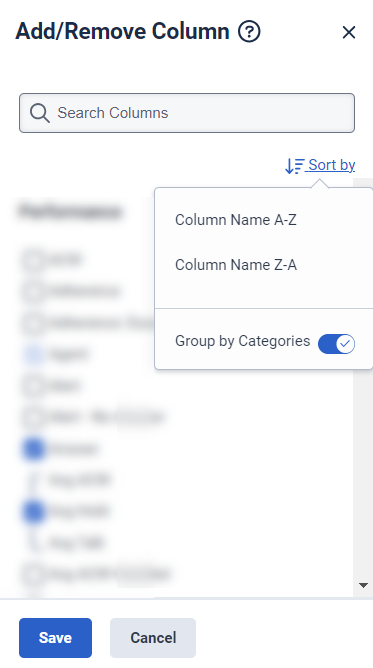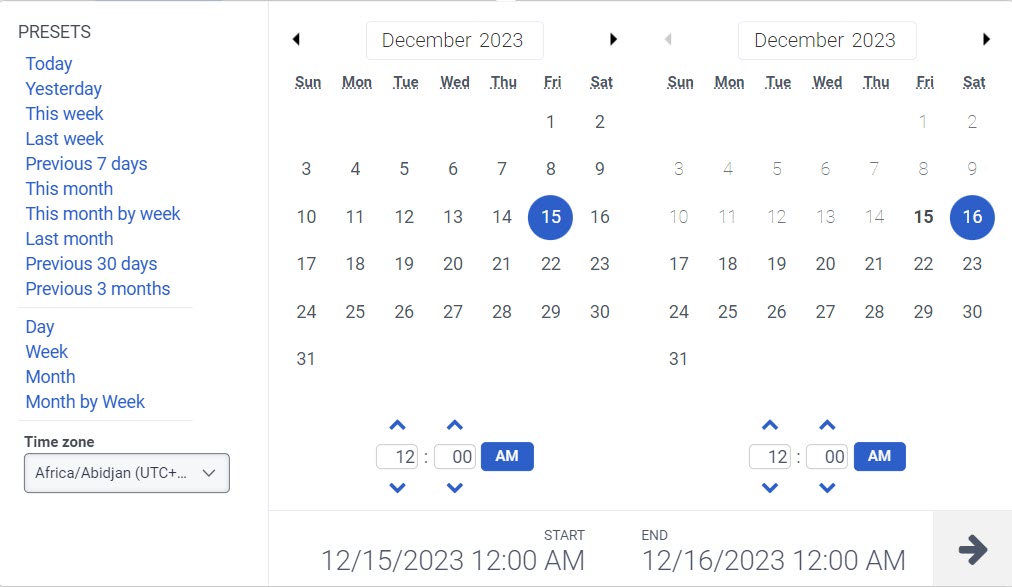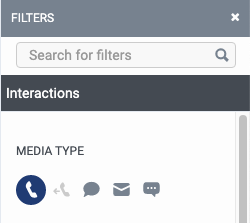Bot Performance Detail view
Administrators can use the Bot Performance Detail view to see operational bot data, such as the number of entries, durations, number of turns, and intents.
To see the view, click Performance > Workspace > Other > Bot Performance. Click the name of a bot to see the detail.
Available columns
To view the available columns, see Bot Performance Detail view section in the View available columns in performance views by category article.
To view the consolidated list of available columns in the performance views, see Consolidated view of available columns in performance views.
To view the list of available columns in the performance views by category, see View available columns in performance views by category.
Set a default time zone in the workspace
You can set the default time zone in the analytics workspace before viewing any analytics view.
To set the default time zone in the workspace, follow these steps:
- Click Performance > Workspace.
- On the left side, from the Time zone drop-down menu, select the required time zone as the default time zone for the analytics workspace.
This view does not update automatically. To see the most current data, click Refresh .
To save the view with your filter and column settings, click Save .
To export the data in the view, click Export .
View version statistics for a bot
To see the bot flow version and related metrics for a bot, click in the bot’s row. The bot versions and their data display under the bot’s row.
For more information about a bot version, click the bot version number. The detail view for that bot opens with the Bot Version filter active to represent that bot version.
Customize the view
Customize the view to show only certain data. For example, you can choose to show only certain columns or filter to see information for certain bots. You can also save your filter and column settings as a saved view to quickly switch between different data of interest in the same view.
To customize analytics views, use the date filter.
To filter metrics by date or configure a custom date range, use presets. When filtering metrics for this view, select any custom date range up to 6 weeks.
To use a preset to filter metrics, complete the following steps:
- To display the date filter, click the date.
- In the Presets list, select a preset date option.
Date presets
| Presets | Description |
|---|---|
| Today | Shows data for the time period that includes the current interval. |
| Yesterday | Shows data for the previous day. |
| This week | Shows data for a Sunday through Saturday time period. |
| Last week | Shows data for the previous week, Sunday through Saturday. |
| Previous 7 days | Shows data for the previous seven days. |
| This month | Shows data for the current month, with no extra days. |
| This month by week | Shows data for the current calendar month starting on Sunday and ending on Saturday, including extra days if the month does not start on Sunday or end on Saturday. |
| Last month | Shows data for the previous calendar month with no extra days. |
| Previous 30 days | Shows data for the previous 30 days. |
| Previous 3 months | Shows data for the previous 3 months. For example, Nov 1, 2022 – Jan 31, 2023. |
| Day | Shows data for a single 24-hour day. |
| Week | Shows data for a Sunday through Saturday time period. |
| Month | Shows data for the exact month with no extra days. If the current month is selected, you can see the data up to the current date. |
| Month by Week | Shows data for a calendar month starting on Sunday and ending on Saturday, including extra days if the month does not start on Sunday or end on Saturday. |
To use a custom date range to filter metrics, complete the following steps:
- Click the date to display the date filter.
- Select a start date and an end date on the calendar, and click the filter arrow .
To view data for a different time period using the same date presets, click the arrows on either side of the date display. ![]()
For example, to view data for the previous day, click the Day preset, and then click the arrow on the left side of the date.
To view data for a different time zone using the same date presets, from the Time zone drop-down menu, select the required time zone. You can create and save reports with the same selected time zone.
- When filtering you can select more than one media type. Click the relevant media type to select or deselect the type.
- You cannot select the voice and callback types at the same time.
- If you select voice, the callback option will be deselected. If you select callback, the voice interaction will be deselected.
- The available media types may vary from those shown above.
The selected media type icon is displayed above the column headers. For more information about various media types and their settings, see the Set behavior and thresholds for all interaction types section in the Create and configure queues.
Data in the view can be displayed in a chart. To view the chart, click the Show/Hide chart icon .
To show or hide columns:
- Click the Pick columns icon on the right side. The Add/Remove Column pane appears.
- (Optional) To sort the columns in ascending or alphabetical order, click Sort by > Column Name A-Z.
- (Optional) To sort the columns in descending or reverse alphabetical order, click Sort by > Column Name Z-A.
- (Optional) To categorize or uncategorize the columns, click Sort by and enable or disable the Group by Categories toggle. Click the image to enlarge.

- Search or scroll to select the columns you want to view. Note: You can also use keyboard navigation to choose the columns.
- Click Save. The selected columns appear on the screen. Note: The column selections appear only after saving the changes and do not apply to the table immediately.
To rearrange the columns, click a column header and drag it.
To reset a view to default column settings, click Reset view to defaults ![]() .
.
You can select up to 20 columns.
For more information about the metrics shown in the columns, see the Available Columns section in this article.
Filter by selecting bots
You can select multiple bots to filter by.
- In the bot’s row, select the check box.
- Continue selecting bot check boxes to add to filters.
- Click Add to filters.
To stop filtering by a bot, above the table, click beside that bot’s name.
To filter by information about the bot, click Filters , and then search or scroll to select the filter that you want to use.
| Filter | Description |
|---|---|
| Bot Product | Displays information for the selected bot products, such as Amazon Lex, Genesys Bot Flow, Google Dialog Flow, and others. |
| Bot Result | Displays information for bot sessions that end with the selected disconnect and exit results. |
| Bot Provider | Displays information for the selected bot providers, such as Amazon, Genesys, and Google. |
| Recognition Failure Reason | Displays information for bot sessions where the bot did not recognize user input due to a specific reason. |
| Bot Final Intent | Displays information for bot sessions that end with a specific, defined intent. |
| Bot Intent | Displays information for bot sessions that include a specific, defined intent. |
| Bot Slot | Displays information for bot sessions that include a specific, defined slot. |
| Bot Version | Displays information for a specified bot version. |
| Message Type | Displays information for one or more message types. |
| Bot Flow Type |
Displays information for the selected bot flow type such as bot, digital bot, unknown, and voice survey. |



